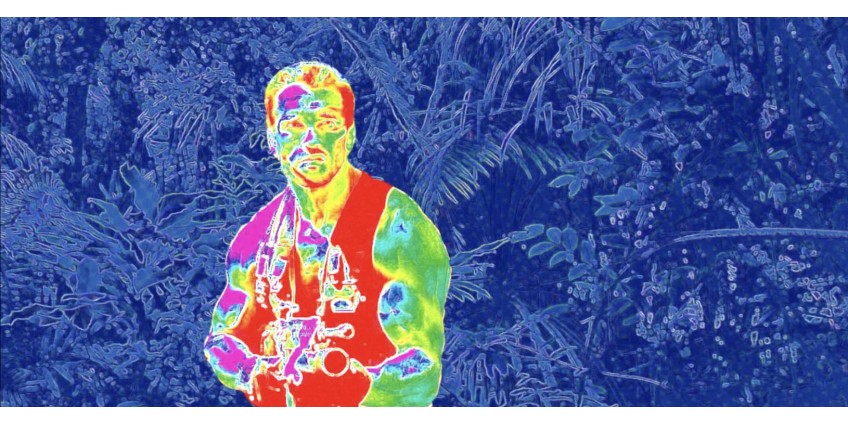
This product is not exportable outside the United States.
By adding this item to cart, you agree and acknowledge the Export Policy and confirm that you are a person in the United States with no intentions to illegally export the device.
This product is not exportable outside the United States.
By adding this item to cart, you agree and acknowledge the Export Policy and confirm that you are a person in the United States with no intentions to illegally export the device.


0

0


If you try to abstract from all modern problems and challenges, you may have an exciting desire to take an honest look at the history of humanity. Not even on history itself, but on what we are of ourselves. You might even want to imagine what we would look like in the eyes of impartial explorers of the future, who look at the artifacts of an ancient civilization, building theories and concepts about our culture and daily life.
Indeed, they would carefully examine the fragments of former greatness, trying to establish cause-and-effect relationships and link together illogical pieces of information that have broken through dozens of centuries. We would be studied as we study ancient, extinct civilizations of the past. Historians read the Eddas and sagas of the Vikings, trying to distinguish truth from fiction and understand how the legendary peoples of Scandinavia, covered in glory, lived. Archaeologists carefully clean the interiors of houses and public buildings of Pompeii from volcanic ash, putting together evidence of the Roman era. Linguists decipher the Sumerian cuneiform to touch the device of a mysterious society.

The truth is that we live in the most rapid period of development that the planet has ever known. Over the past two hundred years, science and technology have made such a quick breakthrough, which was not at all the time before. The industrial revolution, which almost immediately organically turned into the technical processes of the following three stages, gave us a reality that could drive any of our ancestors crazy. It's hard to believe, but the ordinary smartphone that almost everyone has today has more processing power than the first spaceships. Even we cannot realize the greatness and uniqueness that we have received during this time. It is unlikely that future researchers will be able to do this by looking through our chronicles and annals. Although, wait a minute, what kind of chronicles can we talk about if we have long forgotten about them as archaic ghosts of the past. We no longer create information. We live in it.
The history of humanity is written on the flesh of humankind itself, penetrating its soul. We drift in this information field, generating terabytes of data every second. If you want to know up-to-date information for a short period, just open your eyes. If you're going to evaluate something from a perspective, dive into mass pop culture. Here, what is crucial for us and our culture is concentrated.
Every day, whether you're twirling at breakfast, browsing Instagram on the subway, sharing funny Tik-Tok videos at recess, or reading your Facebook news feed, you're at the center of a storm. This tornado of important and worthless news, memes, and advertising is so voluminous and extensive that it simply does not allow you to find everything necessary immediately. But, time reliably filters out fleeting things and insignificant occasions. Everything else remains in our culture.
Therefore, if you want to see and understand the concentrated spirit of a particular era or cultural phenomenon, just look at how it is displayed in films, music, video games, books, and social networks. These industries have become an information repository for everything necessary to society, its past, and development. Any critical event became the plot for a movie or series in history. To date, this trend has only strengthened, reducing the time of filming to a matter of months. See how Netflix or Amazon Prime is investing in the rapid creation of products that artistically reflect on significant events in a short time. As a result, we have a reason and its interpretation. This gives us a fantastic opportunity to evaluate the phenomenon from different angles. Studying these processes from the height of the past tense is awe-inspiring.
For example, today, it is simply amazing to look back and see the whole path that night vision technology has gone through in almost a hundred years. Glorious and speedy development has gone from an idea that seemed like an unattainable dream to cheat evolution to a shocking realization of the absence of any limits. Since WWII, military and civilian science have jumped from primitive, heavy, energy-hungry, and low-efficiency "zero-generation" devices to color-capable, modern, and innovative fourth-generation devices. This achievement of scientists could not take its place in the minds and hearts of ordinary people. So, it has taken a different place in popular culture.
Today, we will try to look into this time capsule and understand what night vision has become for us over all this time. And we will do this by studying the most sensitive industries for scientific inventions - films and video games.
Cinematography not only incorporates all the most current trends. Like science fiction writers, they often produce new ideas, anticipating the future. With night vision devices, it was not quite so. In general, these incredible devices were so complex that few people seriously believed that progress would reach the practical implementation of the plot of the idea.
The first films, where hints of thermal imagers or other low-light surveillance devices began to appear, began to appear in cinemas when these devices were fully used by our army and were baptized in battles and wars.
It was apparent that such powerful equipment provided incredible advantages in combat. It quickly becomes the attributes of a super-warrior and a kind of visualization of invulnerability, like a Superman suit or a Batman mask. The most vivid illustration of this perception was the film "Universal Soldier."
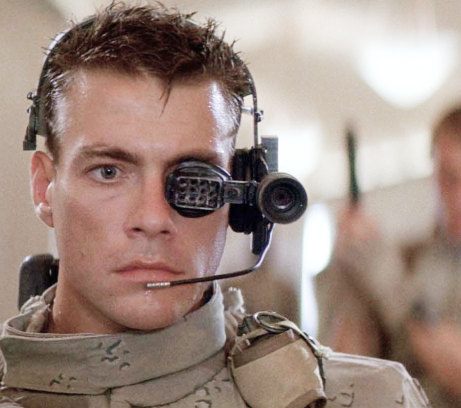
There is no focus on night vision goggles in this film. Instead, there's plenty of classic Jean-Claude Van Damme acting and a stone-faced Dolph Lundgren.
This film was made in 1992 by Roland Emmerich, who later became famous for his passion for large-scale shooting with an abundance of destruction and the destruction of the Earth. His filmography makes me glad that he is a director and not, say, a military one: Independence Day (1996), Godzilla (1998), The Day After Tomorrow (2004), 2012 (2009), Independence Day: Resurgence (2016).
One can argue endlessly about the artistic value of both the common heritage of the famous director and specifically the film Universal Soldier. But, Mr. Emmerich has taste and style. He knows exactly how to create a visual message that will impress any viewer.
The film we are talking about is no exception. Of course, in the context of our topic, there is nothing remarkable in the plot of the film itself. Moreover, this is an ordinary, low-grade action movie with mediocre actors and a plot that is better not to think about while watching. The story does not provide for either cool NVDs or advanced thermal imagers. Neither this film nor its subsequent sequels will please you with scenes with innovative de-wises, but this film has done more for NV technology than any other. Thanks to the posters for the movie with the main characters, whose eye a device resembling a miniature monocular is fixed, their image has become inextricably linked with a night vision device. And the night vision device has become associated with a powerful, calm, and invincible soldier, who alone is worth an entire army. This associative series has become a companion of NVD to this day, even though the film was released thirty years ago.
Many of us now do not imagine a genuine war hero without such an attribute. Even those. Those who haven't watched the movie have probably seen the posters, and these posters are firmly stuck in their heads. And, let's try to forget that the design and this monocular were scrapped from Star Trek: The Next Generation.
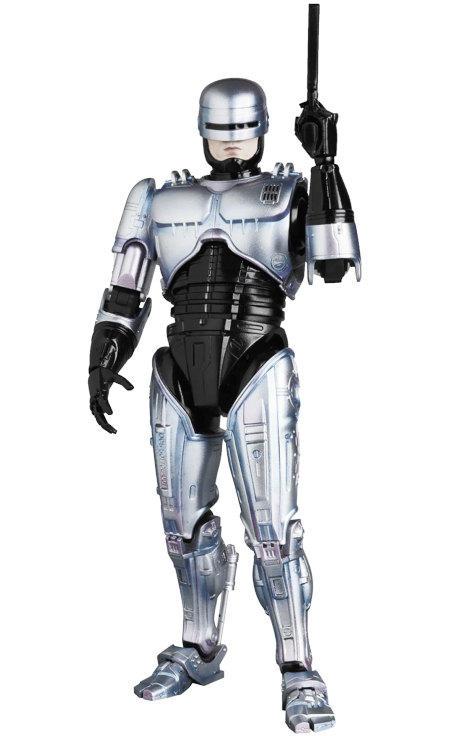
The film Roland Emmerich, starring Claude Van Damme, visualized the disturbing and intriguing symbiosis of man and technology products through its promotional materials. And the film, shot by the Dutch director Paul Verhoeven back in 1987, brought a collective portrait of the police future to culture. This is already a living classic, but it can get a lot of pleasure even today.
Yes, in the course of the story, Robo-Cop's human origins win out, but let's leave this existential suffering for critics. The authors tried to show a terrible future in the spirit of technological cyberpunk and depicted a frightening image of impassive law enforcement and law enforcement machine. We are interested in the ultimate arsenal, with the help of which the man-machine dealt with the bandits. Especially its interface, which is calculated in real-time and visualizes the situation, offers the best combat options. In the context of our conversation, the incident during the cleaning of the house deserves special attention, during which the main character switches the recognition mode to the thermal imaging range. This allows him to identify enemies behind the walls. This is quite ironic because, as we know, even modern thermal vision devices visualize the thermal signatures of objects. But, at the same time, it is pretty easy to avoid thermal vision - you just need to take a position in which there will be something between you and the device that will prevent it from registering your signatures. For example, this object can be ordinary glass or a wall.
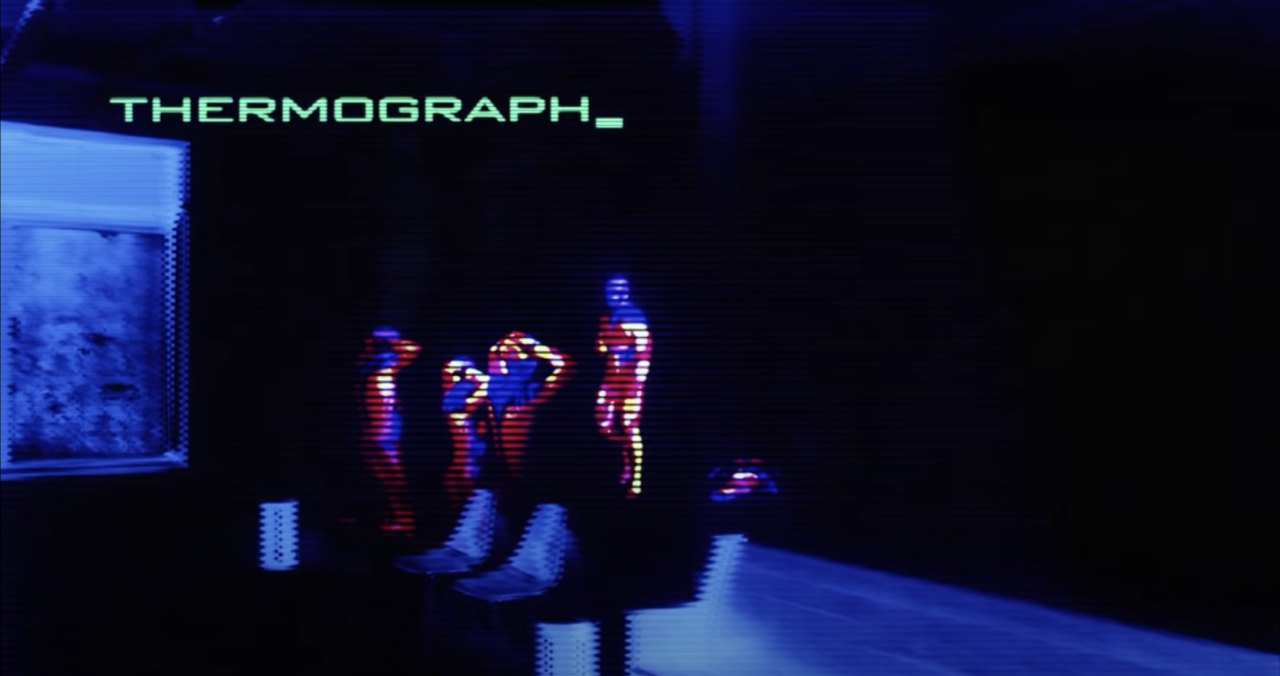
But, in the movie, the robotic cop is so invulnerable and his equipment so flawless and advanced that the movie scene turns the thermal imager into an even more unbelievable thing than it is in reality. This is an excellent stucco moment that influences the plot and will remain in your memory for a long time, firmly proving that this technology can influence the outcome of the battle.
In addition, one cannot help but recall the continuation of the RoboCop series and the 2014 remake. This remake was dull and lost all the original magic, but that spirit of technology's superiority remained in them.

Let's talk about the role of night vision devices as an indicator of the hero's incredible fighting qualities and his danger to enemies. It will be hard for us not to recall this masterpiece of cinema. This is another film from the golden fund of cinema, directed by John McTiernan - a man who knows how to make intense and powerful action films. His portfolio includes such gems as Last Action Hero (1993), The 13th Warrior (1999), and The Hunt for Red October (1990). And, of course, the legendary Die Hard (1988) with a sequel - Die Hard with a Vengeance (1995), with the charismatic Bruce Willis as the sarcastic and fearless policeman John Mcclane.
As you understand, such a person could not help making a fascinating and furious film that launched a long series and created the image of that same Predator - a fearless, cruel hunter and fighter capable of single-handedly coping with an elite special forces detachment.
The confrontation between a man and an alien is very excitingly shown in the film. In many ways, this atmosphere is shaped by the uniqueness of the Predator himself, who looks like a universal killer, without weaknesses and with an incredible arsenal of abilities and weapons. In addition to his intimidating appearance, which makes even a glimpse of him unpleasant, he is striking in versatility. One of the most memorable moments in his hunt for soldiers is tracking them with the help of night vision. But, even an alien monster without pity and weaknesses cannot oppose anything to our earthly incarnation of courage and courage - Arnold Schwarzenegger.
The way these moments were filmed leaves no chance to believe in a successful outcome for the special forces. The visualization of these scenes is firmly integrated into your memory. The predator can recognize the heat signatures of the prey. For many years, ordinary people strongly associated thermal imagers with this antagonist. The way the alien uses this function instills in the viewer the awareness of the inevitability of the defeat of his victims. Of course, the hero Arnold Schwarzenegger finds a way to fight the hunter and defeat him. But, this is just an artistic assumption, which is practically impossible to realize in life.
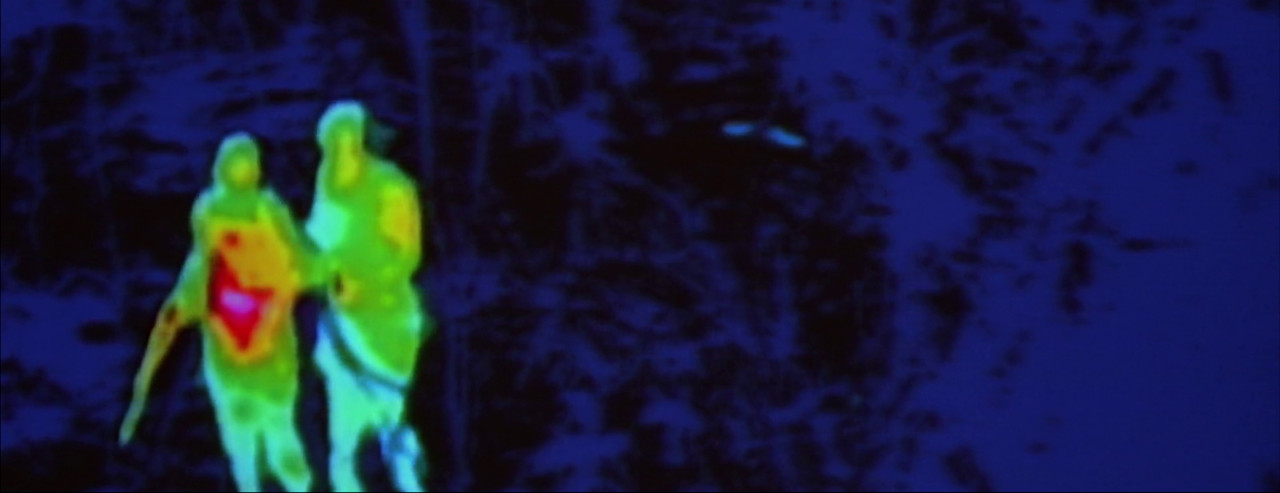
To hide from the all-penetrating gaze of the monster, Major Alan "Dutch" Schaefer puts dirt on the body, which makes it invisible to the thermal imager. In life, this does not work quite like that. The technology registers the temperature of all objects that are warmer than absolute zero. To hide from it, you need to deprive it of the ability to capture the object's temperature. As we wrote above - you need to have some kind of obstacle between you and the devices. Or you can wrap yourself in some sort of material that will not let the heat of your body. But, as practice shows, it is difficult to do this since heat will quickly penetrate through the material.
But, today, we will not focus on this. We are interested in the Predator film because of its vast imprint on culture. And, it became legendary, mainly due to this canonical scene and how popular it became among ordinary people who have never held real thermal vision goggles or thermal monoculars in their hands. Millions of viewers got a glimpse of how this mysterious technology works and what benefits it can provide. And, combined with the film's place in history, this is the best advertisement for a weird and innovative technology.
There is another point that seems interesting to us. Predator is weak. In any case, without his costume, without weapons, without a helmet. The helmet allows him to see in different ranges, which is exceptionally well shown in the second part of the series. He resembles a person whose capabilities were not provided by nature and evolution. But, science, which gave us the most incredible devices, lifted us to the top of the food chain. Through such a prism of perception, the confrontation between the Predator and the elite fighters begins to resemble a shadow fight because we are too similar to the film's anti-hero, which brings extra intrigue and depth to this exciting action movie.
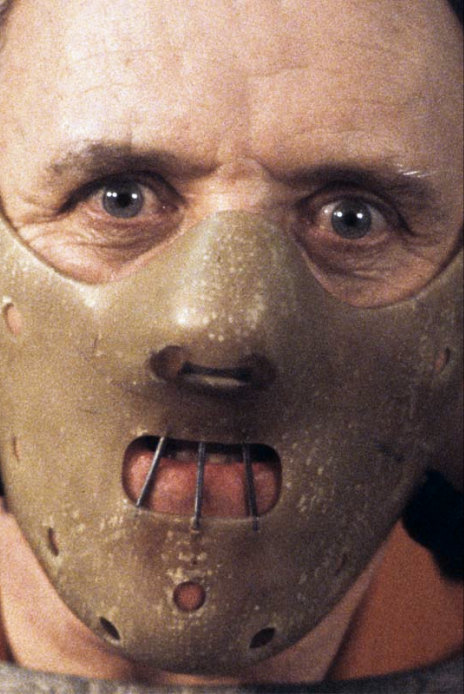
A living classic that has become a household name, adorned with magnificent acting works by Sir Anthony Hopkins and Jodie Foster, has forever taken its rightful place in the golden fund of world cinema. We could not ignore this legendary film with a night vision device's canonical and pivotal scene. She gave us the common name Dr. Hannibal Lecter, which has become closely associated with the image of an intelligent, sophisticated, and insidious cannibal. This image is so firmly rooted in popular culture, and the acting work of Sir Anthony Hopkins was so convincing and monumental that he was even abandoned by a girlfriend who could not separate the image of an evil maniac from the charismatic, intelligent, and talented genius of our time.
The Silence of the Lambs was filmed over thirty years ago, but to this day, this film constantly finds itself in various lists and ratings of the best movies and the best horror movie. Moreover, the picture is added to multiple ratings composed of both critics and ordinary viewers. The film by Jonathan Demme won five major Academy Awards: Best Adapted Screenplay, Best Director, Best Picture, Best Actor, and Best Actress. Overall, the number of awards the film has garnered is enormous, and they are all well deserved.
The plot of the film is simple at first glance. FBI agent Clarice Starling is on the trail of a brutal maniac dubbed "Buffalo Bill" by the newspapers because of his habit of flaying his victims. The heroine's adversary Jodie Foster is so sophisticated and intelligent that the agency is forced to bring in the killer and cannibal Dr. Hannibal Lecter, who is held in a secure block of a psychiatric hospital, as a consultant. The chemistry between the actors created an unforgettable atmosphere of tension and multi-level psychological play in communication between an FBI agent and a dangerous psycho. We will not reveal the plot and spoil your viewing pleasure. But, we cannot do without one spoiler since it is crucial and built on our conversation's main object.
At the film's climax, FBI agent Clarice Starling locates the killer's home and arrives there to arrest him. This outcome of the film is the highest point of permanent tension in which the viewer has been all the time before. Even if we discard the parallel events with the hero Sir Anthony Hopkins, the scene in the lair of the maniac keeps us in incredible fear. The tension reaches its peak when Clarice Starling descends into the basement.
This episode becomes the quintessential confrontation, which lasted the entire timekeeping, and the philosophical morality embedded in the plot. In search of "Buffalo Bill," Clarice descends into the basement, unaware that she is no longer a hunter, but a victim, because a maniac is watching her. And, at that moment, when the agent sees a nightmarish picture of a mummified corpse in the bathroom, the killer turns off the light.
Disoriented and frightened, the woman wanders in the dark, holding on to the wall and looking around in the impenetrable darkness where the brutal killer hides. The suspense reaches its maximum when the camera cuts to "Buffalo Bill," who is equipped with night vision goggles. He silently follows the hunted down and the FBI agent, almost touching her face. He enjoys his superiority, which he was given by new technologies that can save the good guys and help the villain in his bloody plan. When it seems this is the end and Clarice Starling is about to be killed by a ruthless maniac, the plot takes a sharp turn. "Buffalo Bill" aims at a defenseless woman with his revolver, and, at the moment when the viewer is convinced that the fate of the main character is already sealed, the antagonist cocks the trigger. Focusing on the click of the cocked hammer, the agent fires in that direction, killing the hunter.
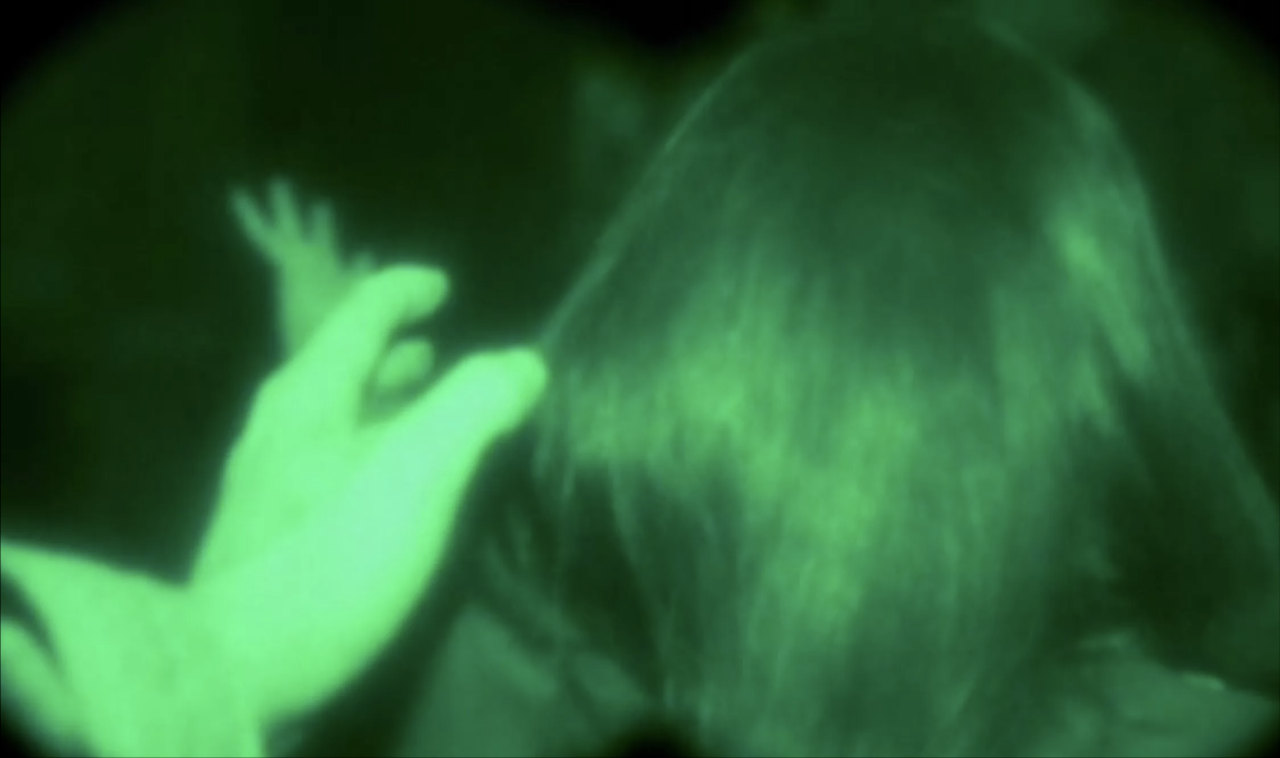
This is an incredible scene that has become classic and canonical, not only in the context of the use of night vision goggles. The Silence of the Lambs gave us an incredible experience of looking at the world through the green light of night vision. This short hunter-prey position and Clarice Starling's excellent acting made the viewer show maximum empathy. Of course, the authenticity of displaying work with NVD does not entirely reflect reality, but we will return to this issue below.
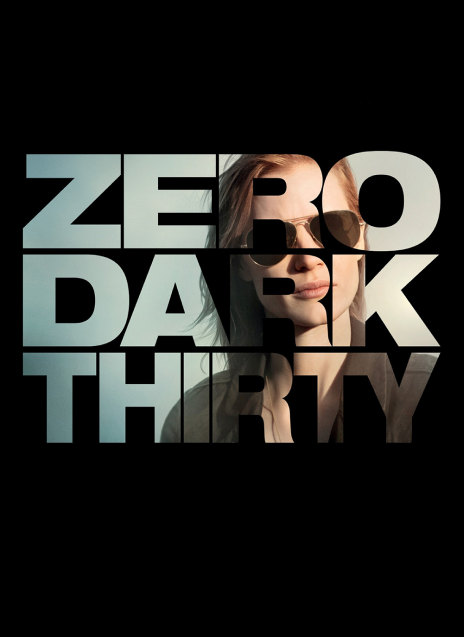
Every director has a genre in which he works best. Among the best directors, this division is even more pronounced. Roland Emmerich is a master of destruction, Jim Jarmusch is a specialist in intellectual, subtle dramas, Woody Allen is a creator of tender and unusual melodramas, and Guy Ritchie is a master connoisseur of the ironic underside of the criminal world. This list can be continued for a long time, and every eminent director will have a niche with which he is associated with the average viewer. Whatever rating you make, Kathryn Bigelow will be in it. This amazing woman makes the most touching, courageous, and dramatic films about soldiers. Her specific vision allows viewers to see the life of the army from a completely different angle. Movies such as Triple Frontier, The Hurt Locker, which won the 2010 Academy Award for Best Director and Best Picture, and Zero Dark Thirty have become classics of the military drama genre. They are made with special love and understanding of the inner world of the American army.
Thanks to the combination of these factors, Kathryn Bigelow was entrusted with the film adaptation of one of the most critical events in the long US war against the global terrorist threat - the elimination of Osama bin Laden. The director shot not just an excellent dramatic film. Zero Dark Thirty is simply a fantastic masterpiece that not only touched the viewer but was also highly acclaimed by critics, becoming the best film of 2012. This work became a kind of requiem for the tragedy of 9/11.
Pumping style, drama, and impeccably constructed script end with an incredible scene of the operation to eliminate the criminal responsible for the bloody crime that shocked the entire nation. The pivotal scene is the film's finale, which shows the process of our special forces, for which the country has been preparing for many years. We can see the impeccable operation of the US Army fighters, and part of it is shown in the first person, allowing us to feel like a soldier in night vision goggles. It's an incredible and satisfying experience, and it's because of the shooting "from the eyes" using night vision that it becomes so.
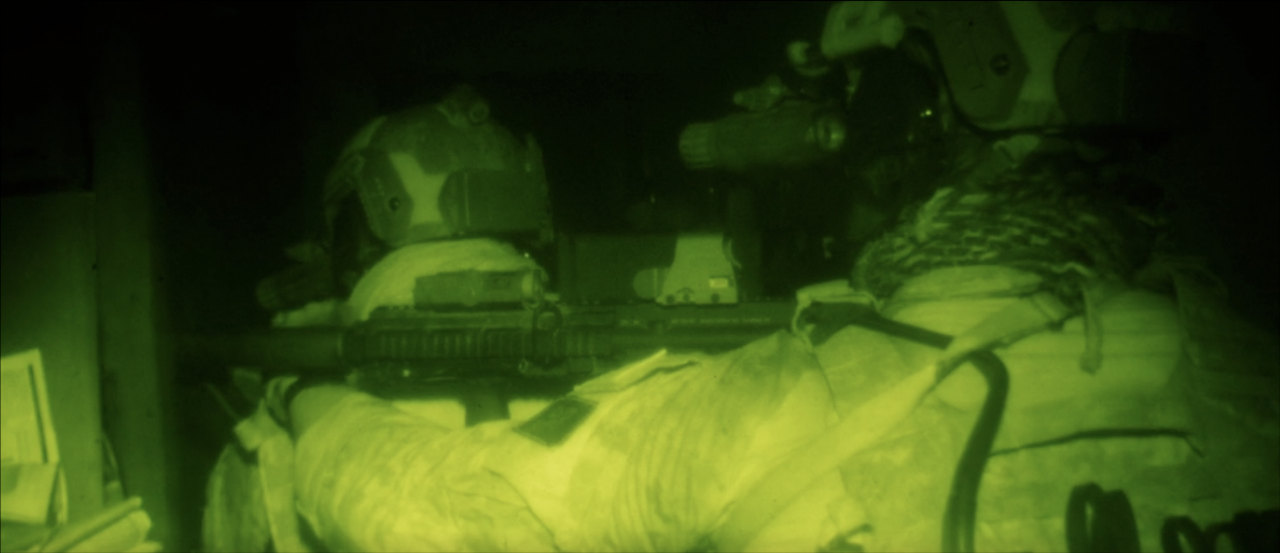
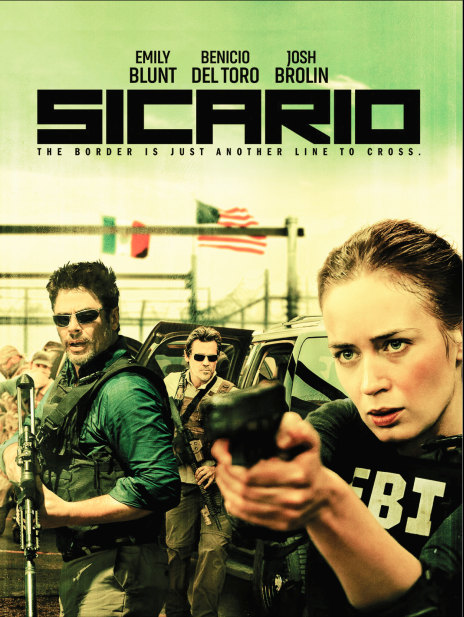
This is a challenging and uncompromising action movie about the bloody world of drug cartels and drug smuggling. Sicario has assembled an excellent cast with stars like Josh Brolin, Emily Blunt, John Bernthal, and Benicio del Toro. Before the brilliant Denis Villeneuve directed Arrival, Blade Runner 2049, and Dune, which made him the best director of modern sci-fi films, he had other worthy works.
We cannot advise you to watch Sicario unless you are confident and not too impressionable. The brutality and realistic manner of filming will leave you with heavy feelings after watching. Still, the ability of the director to get right into the viewer's soul is precisely what distinguishes a good film from a bad one.
Apart from many fantastic shots and scenes in Sicario, the tunnel firefight stands out. It passes at night and is shown to us with the help of night vision devices from all sides. And, you know what? This is probably the weakest part of the film. It was not filmed in the best way, and everything is terrible: both the editing and the operator's work. But worst of all is the night vision shots. You will get the impression that you will win some free games on your iPad.
A great idea and staging are incredibly spoiled by the dubious quality of night shooting with night vision devices. Moreover, one gets the impression that a long scene, in which it is difficult to distinguish something due to color correction and dubious editing, was generally written at the last moment and was absent from the initial script. Many questions are answered if you know that the sponsor of this film in general and in a particular episode is one of us night vision manufacturers. His name can be found in the credits for the movie Sicario. I don't think we have anything against advertising and commercial collaborations. But, you must admit that any product placement must be of high quality and seamlessly integrated into the product. Here we see a long and tedious commercial of the NVD brand, which gets out of the story and slows down the story's pace.
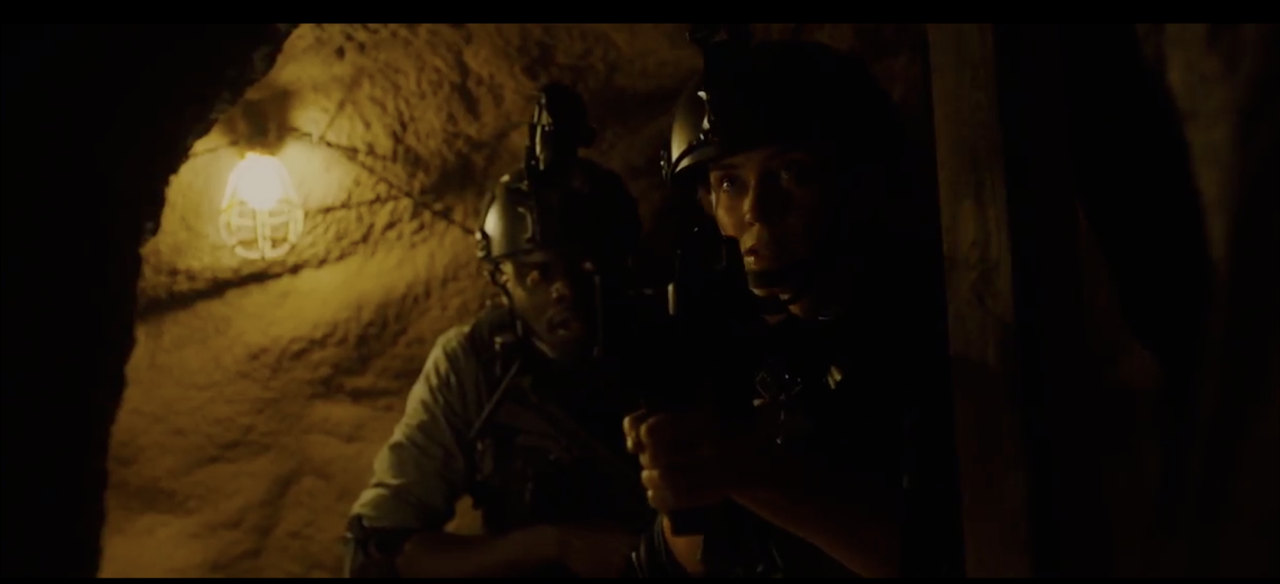
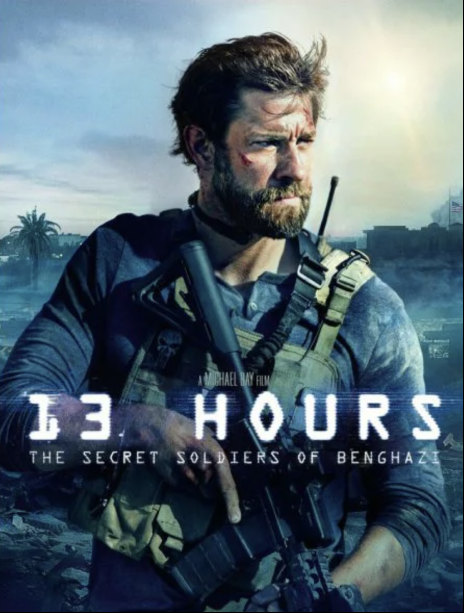
Michael Bay is a recognized specialist in the production of video attractions. This man gave us movies like Bad Boys, Armageddon, Pearl Harbor, and, of course, the Transformers franchise. He is hated by critics and adored by explosives and pyrotechnics salesmen. Both of them are not wrong. Critics have a lot of complaints about Michael because of frankly bad films: without a plot, nightmarish editing, lousy acting, idiotic dialogues. One could go on and on with a long list of the shortcomings of his films, but they can all be boiled down to one thing - visuals and giant explosions. For this, by the way, sellers of pyrotechnics adore him. All this forms the unique style of Michael Bay. Yes, it is peculiar and can turn even a frightening real story from real life into a bright, implausible attraction, as it was in Pain & Gain.
Should such an artist be trusted with the film adaptation of the attack against two United States government facilities in Benghazi Islamic militant group Ansar al-Sharia, called The Benghazi attack, which happened in 2012? The question is open.
This is a heroic story about brave people who are faithful to their duty to the end and are ready to sacrifice their lives for the safety of others. Six fighters of private military contractors from GRS (Global Response Staff) and two agents of the US State Department (Diplomatic Security), in an unequal battle, opposed the terrorists, who greatly outnumbered them. A heroic and tragic story that deserved a more touching and dramatic adaptation. But no. Michael Bay took over...
James Badge Dale and The Office television series star John Krasinski (yes, we know that John is a great multifaceted actor, director, and screenwriter, but for us, he will always be Jim from The Office) were responsible for the embodiment of the heroic characters of the film. It was they who brought the director's ideas to life. One of these ideas was the defense of the building at night when the main characters fired back at the terrorists while on the roof. It was a spectacular scene with many explosions (who would doubt it).
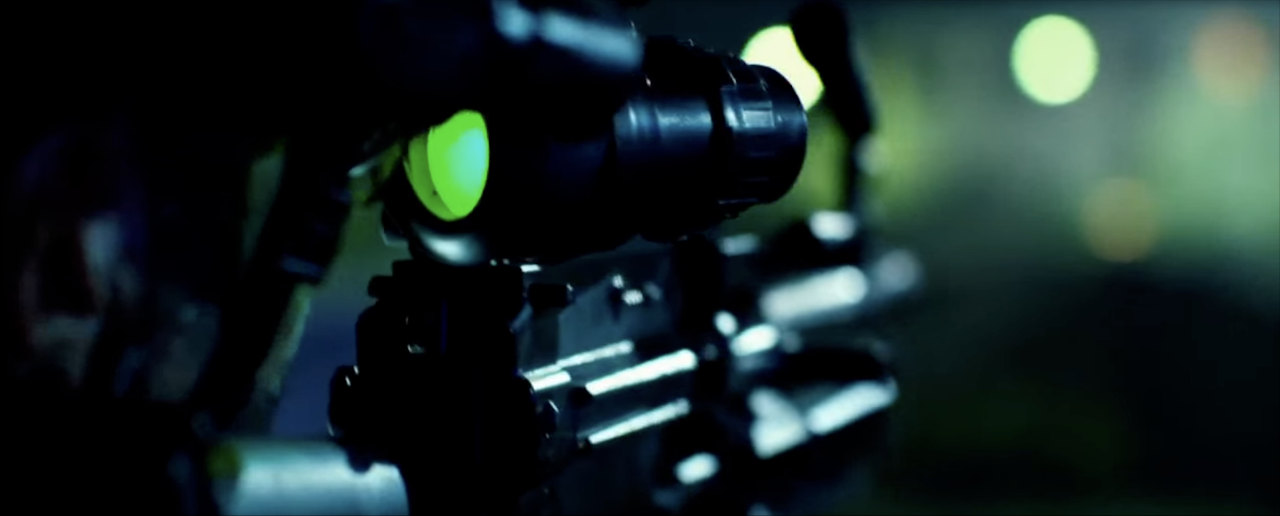
Despite the showiness of this segment of the film, several aspects are pretty confusing to us. Firstly, the main characters shoot enemies at night with fantastic accuracy do not have NV scopes on their rifles. They use night vision goggles, aiming through regular weapon sights. Of course, this is possible, and some hunters and soldiers use this firing method, but it requires preliminary manipulation and preparation and is unlikely to allow such effective fire. Secondly, considering what has already been said, the shooters faced constant explosions in the firing zone. And, as you understand, bright flashes are not the best friends of night vision devices. And, the glare from them does not contribute to improving the accuracy of shooting and the service life of your NVD.
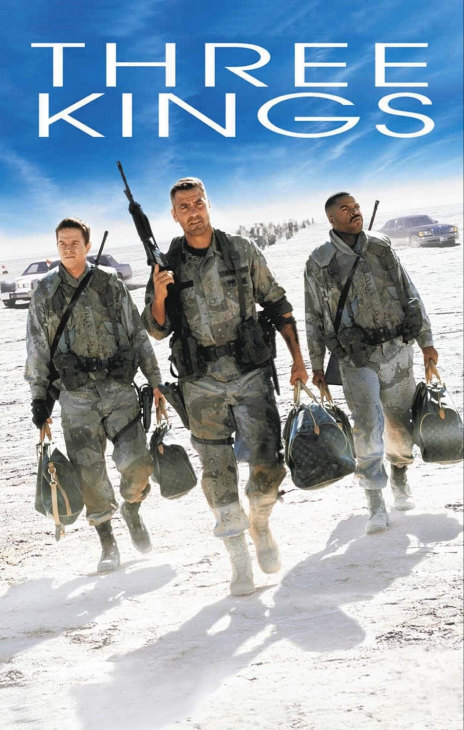
We couldn't help remembering this magnificent, funny, and sad film simultaneously, with an incredible team of actors with a unique chemistry. George Clooney, Mark Wahlberg, and Ice Cube marvelously embody the atmosphere of absurdity and strangeness in the most inappropriate place possible - in war. But, even in such conditions, there is time and feelings to prioritize correctly and realize that the principal value in life is not money, not gold.
But where are the night vision devices? We will answer. That hilarious moment when the conspirators who found the map decide to plan an operation to "rescue" the gold, they send one of the soldiers to guard the entrance to the tent. And he does this task meticulously by wearing NV goggles, despite the daytime. The scene with him and the hero George Clooney is hilarious and ridiculous, especially the shots from the eyes of the hapless soldier.
Night vision devices have firmly taken a special place in popular culture and cinema. Many directors use NVD, as this unique technology allows you to quickly and easily create the right atmosphere, understandable to any viewer. We did not remember all the films in which these devices were used. We did not recognize the movie in which they used night vision technology even though there are a lot of them. Rec and its remake Quarantine, 28 Weeks Later, Cloverfield, Troll Hunters, and many horror movies in different categories.
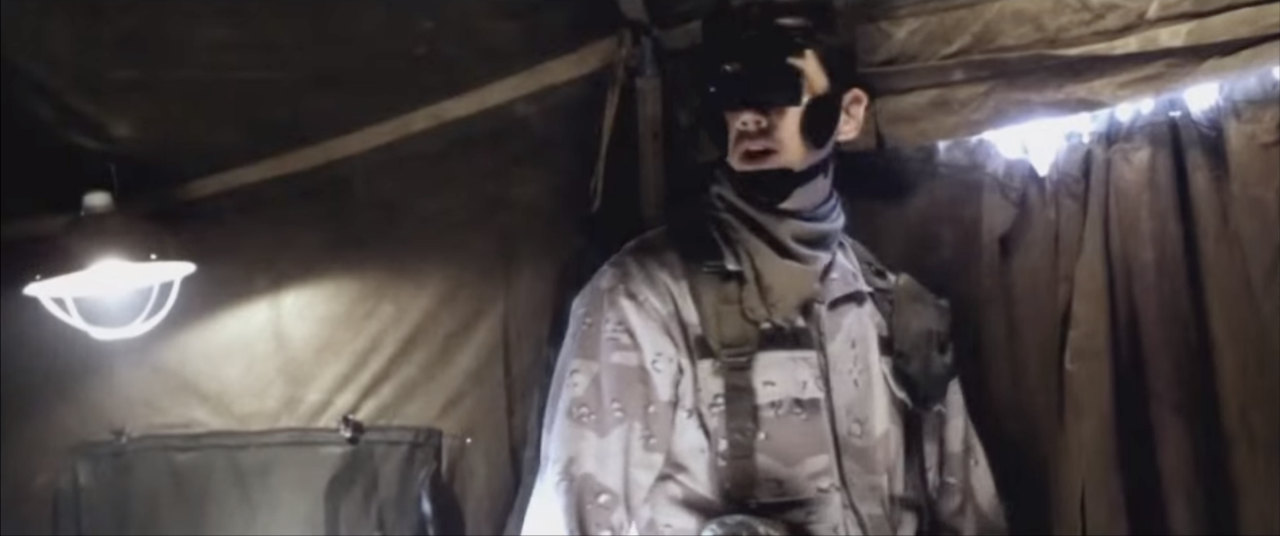
Three Kings 10:30 timeline
Today we have brought you a shortlist of works of popular culture that allow you to look from the side using the ability to see the world in the darkness of the night. In the next part, we will up the ante and tell you about video games that allow you to get a direct virtual experience using night vision goggles.
Table of contents